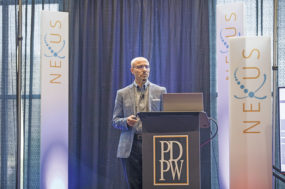- DMC supplemental payments, other dairy aid on a timeline
- FMMO reform webinar series continues
- Global Dairy Trade index declines
- Dairy Defined: A world without cows
- Two decades in the making: FDA publishes final rule on yogurt standard of identity
- Delays sought on implementation of EU import certification requirements
- Things you might have missed: Ag labor, the Packers and Stockyards Act, the return of WOTUS, JBS ransom payment and more
DMC supplemental payments, other dairy aid on a timeline
U.S. Ag Secretary Tom Vilsack announced additional details regarding USDA pandemic financial assistance for agricultural producers, including dairy farmers. The USDA will implement the assistance within 60 days of the announcement on June 15, according to the USDA press release.
Included in the announcement is mention of supplemental Dairy Margin Coverage (DMC) payments for small and medium producers, a provision approved in last December’s COVID-19 relief bill. According to the USDA, the outlay for the supplemental DMC payments is approximately $580 million.
The COVID-19 relief bill included language directing the USDA to allow smaller dairy producers to update their milk production history baselines and receive a supplemental DMC payment on a portion of any increased milk production, up to the Tier I cap of 5 million pounds of milk per year. (Read: Weekly Digest: USDA moving forward on DMC production history adjustment rule.)
Through April, DMC indemnity payments had been distributed every month of 2021, totaling $446.1 million as of June 7. It is anticipated supplemental payments to eligible producers will be retroactive to January 2021 and run through the end of 2023. The May 2021 DMC margin and potential indemnity payments will be announced June 30.
As part of the Pandemic Assistance initiative announced in March, the USDA also provided advance notice of minimum provisions to be included in a Dairy Donation Program (DDP). The plan requires participating dairy cooperatives and processors to have a donation and distribution plans describing the process to be used for the donation, processing, transportation, temporary storage and distribution of eligible dairy products. Specific regulations regarding the program, however, have not been published.
Also, in April, the USDA opened the sign-up period for Coronavirus Food Assistance Program (CFAP) payments to dairy producers who missed earlier sign-up periods and payments.
FMMO reform webinar series continues
Another thing dairy producers have been waiting on is news of a possible USDA hearing to consider Federal Milk Marketing Order (FMMO) reforms. While there’s been nothing official to report since the National Milk Producers Federation’s (NMPF) board of directors voted in late April to request an expedited FMMO hearing limited to proposed changes to the Class I mover, a group of Midwest dairy organizations continues an educational webinar series addressing potential FMMO reform ideas being discussed.
In the latest webinar, recorded in late May, dairy economist Marin Bozic delves into the impacts of changes to the Class I mover price formula, market disruptions caused by the COVID-19 pandemic, and the extreme spread between FMMO Class III and Class IV milk prices and the impact on producer price differentials (PPDs).
The webinar series is hosted by the Dairy Business Association, Edge Dairy Farmer Cooperative, the Iowa State Dairy Association (ISDA), Minnesota Milk Producers Association, Nebraska State Dairy Association and South Dakota Dairy Producers. Five of the six organizations (all except the ISDA) have offered their own plan in the event the hearing process proceeds. In the latest webinar Bozic discussed that plan, as well as those from NMPF and FarmFirst Dairy Cooperative, reviewing trends in Class I fluid milk sales and dynamics that led to the current debate and explored potential consequences of reform proposals on producers' milk checks and risk management strategies, as well as milk consumers.
The next webinar, scheduled for June 25, will discuss “Make allowances: The problems with them and potential solutions."
Bozic said any FMMO hearing process, even in an expedited format, would take nine to 12 months before any changes could be implemented.
Global Dairy Trade index declines
The index of Global Dairy Trade (GDT) dairy product prices fell 1.3% in the latest auction, held June 15, extending the trend of small declines that started in April. A price summary of individual product categories follows:
- Skim milk powder was down 1.7% to $3,356 per metric ton (MT).
- Butter was down 1.7% to $4,612 per MT.
- Whole milk powder was down 1.8% to $3,997 per MT.
- Cheddar cheese was up 0.2% to $4,328 per MT.
- Anhydrous milk fat was up 0.6% to $5,687 per MT.
The next GDT auction is July 6.
Dairy Defined: A world without cows
With the dairy industry the target of criticisms from “big oil” to vegan activists, NMPF called attention to an article noting dairy provides solutions to many global challenges.
“A World Without Cows: Imagine Waking Up One Day to a New Reality” is a piece written by Dr. Mitch Kanter and Donald Moore from Global Dairy Platform, an international industry organization that aims to demonstrate dairy’s contributions to global food systems, healthy diets and sustainable livelihoods and lead collaborations that enhance them.
According to the authors, a world without dairy cows would mean:
- Nutrition would be poorer, and the poorest would be worst off.
- The earth’s ecology would suffer.
- Greenhouse gas benefits would be limited.
- Developing-world farmers would face poverty.
Read NMPF’s recent Dairy Defined post.
Two decades in the making: FDA publishes final rule on yogurt standard of identity
The FDA issued a final rule, June 11, to amend and modernize the standard of identity for yogurt. It took a while.
The National Yogurt Association, which was since dissolved and became part of the International Dairy Foods Association (IDFA), petitioned the FDA for changes in February 2000. The FDA issued a proposed rule on Jan. 15, 2009. The final rule was published in the Federal Register and is effective July 12, 2021, while the compliance date is Jan. 1, 2024.
The final rule expands the allowable ingredients in yogurt, including sweeteners and reconstituted forms of basic dairy ingredients. It establishes minimum amounts of live and active cultures based on labeling claims.
Currently, the FDA has separate standards of identity for yogurt, lowfat yogurt and nonfat yogurt. Under the final rule, lowfat yogurt and nonfat yogurt will be covered under FDA’s general definition and standard of identity, which allows nutritionally modified versions of traditional standardized foods.
Delays sought on implementation of EU import certification requirements
Several dairy state lawmakers asked European Union (EU) Ambassador Stavros Lambrinidis to work to delay implementation of new EU import certification requirements which go into effect on Aug. 21. Signing the letter were U.S. Reps. Ron Kind (D-Wisconsin), Jackie Walorski (R-Indiana), Jim Costa (D-California) and John Katko (R-New York).
The European Commission published new certification requirements at the end of 2020 for a wide range of food products, including dairy. Two sets of new requirements have posed concerns to the U.S. dairy industry: (1) revised import certificates for dairy products and (2) new certification requirements for “composite products”: processed food products that contain ingredients of both animal and plant origin.
The letter cites “asymmetry” in the EU-U.S. trade relationship: U.S. dairy exports to the EU total about $100 million annually, less than one-tenth the amount exported annually from Europe to the U.S.
U.S. dairy organization leaders call the new import certification requirements unwarranted, charging they fail to recognize the safety of U.S. dairy products and the high level of animal health protections.
“If the EU wants to steer its trade relationship with the U.S. toward stronger ground, it should start by changing its plan to choke off access for dairy and other products later this summer," said Krysta Harden, president and CEO of the U.S. Dairy Export Council.
"U.S. dairy farmers and processors continually have to chase new mandates by the European Union to retain our current access, even when there are no safety concerns with American dairy products. This type of unwarranted red tape is exactly the type of nontariff trade barrier that drives a gaping dairy trade deficit between the U.S. and the EU," said Jim Mulhern, president and CEO of NMPF.
Things you might have missed
-
Organized by the Agriculture Workforce Coalition, a letter from early 300 organizations asks Senate leaders to take action on agricultural labor reforms, especially the existing H-2A visa program. Among those signing the letter were NMPF and other national, regional and state dairy groups and businesses.
-
The USDA is beginning work on three proposed rules enforcing the Packers and Stockyards Act. The 100-year-old law was originally designed to protect U.S. livestock producers from unfair, deceptive and anti-competitive practices in the meat markets.
-
The EPA intends to initiate a new rule-making process that restores the so-called Waters of the U.S. (WOTUS) rule. The process seeks to repeal the Navigable Waters Protection Rule, implemented by the Trump administration and replacing Obama-era Clean Water Act regulations.
-
The USDA started making $1 billion in Quality Loss Adjustment (QLA) Program and Wildfire and Hurricane Indemnity Program Plus (WHIP+) payments for losses suffered in 2018-19. QLA provides assistance to crop and forage producers; WHIP+ payments, the second under the program, cover losses of crops, trees, bushes and vines. All producers receiving QLA Program and WHIP+ payments are required to purchase federal crop insurance or Noninsured Crop Disaster Assistance Program coverage for the next two available crop years.
-
JBS USA confirmed it paid the equivalent of $11 million in ransom in response to the criminal cyberhack against its operations. Over the Memorial Day weekend, JBS, responsible for nearly 25% of the American beef market, was forced to shut down all of its U.S. beef plants. JBS plants in Australia and Canada were also affected.

-
Dave Natzke
- Editor
- Progressive Dairy
- Email Dave Natzke







